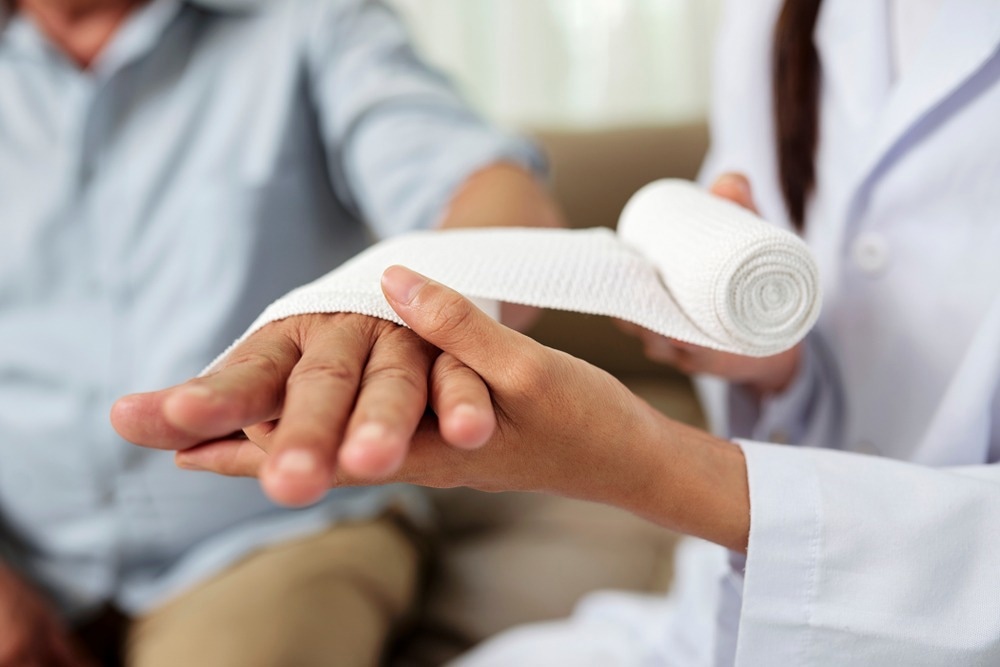In a recent study published in Nature Communications, researchers developed a microneedle (MN) bandage containing selenium (Se) and chlorin e6 (Ce6) hybrid nanoparticles (SeC@PA) for diabetic wound therapy.
 Study: Biofilm microenvironment triggered self-enhancing photodynamic immunomodulatory microneedle for diabetic wound therapy. Image Credit: Dragon Images/Shutterstock.com
Study: Biofilm microenvironment triggered self-enhancing photodynamic immunomodulatory microneedle for diabetic wound therapy. Image Credit: Dragon Images/Shutterstock.com
Background
Chronic wounds are common complications of diabetes. Current treatment methods to manage them include aggressive debridement, antibacterial therapy, bioengineered alternative tissue products, and surgical angiogenesis, which are less effective for diabetic wounds. Therefore, versatile therapeutic approaches combining anti-inflammatory, pro-angiogenesis, and antibacterial effects are needed. Diabetic wounds are often infected with biofilms.
The extracellular polymeric substances of biofilms protect bacteria from immune cells and antibiotics. These biofilms display distinct microenvironments, such as high glutathione (GSH) levels and low pH, in wound beds. Thus, exploiting these unique characteristics can be promising for preventing biofilm infections. Photodynamic therapy is a minimally invasive procedure without concerns about drug resistance, but there are some limitations, including the depletion of reactive oxygen species (ROS) by GSH in biofilms.
The study and findings
In the present study, researchers developed a multifunctional MN bandage to treat diabetic wounds. They prepared Se- and Ce6-containing nanoparticles (SeC@P) coated with dopamine, followed by the adsorption of L-arginine (LA) on the surface to generate SeC@PA. Accelerated release of Ce6 was observed at pH 5.5; likewise, Se was also released at the same pH.
Next, the researchers tested whether singlet oxygen generated by Ce6 could oxidize LA to generate NO to deplete GSH and produce reactive nitrogen species (RNS). This showed the successful production of nitric oxide (NO) upon laser irradiation, which correlated with SeC@PA concentration and irradiation intensity.
Moreover, the singlet oxygen also oxidized the released Se. Additional experiments indicated that laser-irradiated SeC@PA [SeC@PA(+)] was involved in GSH degradation and increased RS levels at high GSH levels and functioned as a reactive species (RS) scavenger at low GSH levels, demonstrating bidirectional RS regulation.
Next, the researchers prepared a SeC@PA-loaded MN bandage and tested its anti-biofilm effect against Pseudomonas aeruginosa and Staphylococcus aureus. They observed potent antibacterial effects at higher concentrations of SeC@PA(+) as well as stronger cytotoxicity. Therefore, they optimized the concentration to 20 µg/ml, 7.2 µg/ml, and 10.8 µg/ml of Se, Ce6, and LA, respectively.
Further, the team examined the effects of SeC@PA on macrophage polarization. M1 and M2 phenotype macrophages were identified by their C-C chemokine receptor 7 (CCR7) and cluster of differentiation 206 (CD206) markers, respectively, and treated with SeC@PA(+). This significantly increased the proportion of CD206+ M2 macrophages and reduced CCR7+ M1 macrophages.
Moreover, interleukin (IL)-4 and IL-10 levels were significantly increased following treatment in M2 macrophages, whereas tumor necrosis factor (TNF)-α and IL-1 levels were reduced. Next, the RS-scavenging effect of the SeC@PA MN bandage on non-biofilm-infected wounds in diabetic mice was investigated.
RS levels were significantly reduced in wound tissues after applying the laser-irradiated SeC@PA MN bandage [SeC@PA MN(+)]. Moreover, regular skin structure, increased density of blood vessels, and enhanced collagen deposition were noted with SeC@PA MN(+). Next, the therapeutic effects of SeC@PA (+) and SeC@PA MN were compared. The researchers noted that SeC@PA MN (+) had a greater effect on wound healing than SeC@PA(+).
They also examined the effects of SeC@PA MN on biofilm-infected chronic diabetic wounds. Wound healing was significantly enhanced with SeC@PA MN (+), achieving over 95% healing after 16 days. Moreover, the dermis and epidermis in treated wounds were highly ordered and relatively intact at day 16, with reduced inflammatory cell infiltration. Besides, treated wounds showed increased infiltration of M2-phenotype macrophages and decreased infiltration of M1 cells.
Conclusions
Taken together, the researchers developed and characterized the SeC@PA MN bandage for diabetic wound treatment. MNs ruptured the physicochemical barriers covering the wound and delivered cargo to tissues and biofilms beneath the wound covering, increasing bioavailability. When delivered to wounds at high GSH levels, SeC@PA (+) caused an RS storm through hydroxyl radicals and RNS, eradicating the biofilm.
At low GSH levels, SeC@PA functioned as an RS scavenger, elevated the levels and activity of glutathione peroxide, and reduced inflammation in the wound. In addition, SeC@PA can polarize macrophages into the M2 phenotype, which can mount a sustained anti-inflammatory response through (increased levels of) IL-4 and IL-10. Overall, the study demonstrated a potential therapeutic strategy to treat chronic wounds by targeting the distinct microenvironments of wound beds and biofilms.